Settlements
In present time only Norway, Russia and Poland keep continuing presence on Svalbard. Vast majority of the settlement in concentrated in Nordenskjold land area mainly on the coast of Isfjord.
Norwegian settlement
Longyearbyen (LYB)
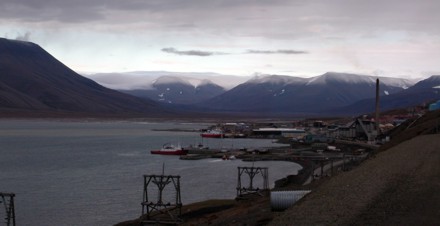
LYB is administrative center, town of more than 1700 inhabitants, the northernmost family settlement. Originally it was a mining community. Today, most mines in the vicinity has been closed down and town makes its living of tourism.
Shops and services are abundant so any young backpacker and most likely any spoiled tourist, will find his needs fully satisfied. We sould definitely note the local church that serves in the rough svalbardian country as a good sanctuary to both body and spirit.
The only svalbardian airport for large airliners is located 5 km northwest from town. There is a campsite near the airport.
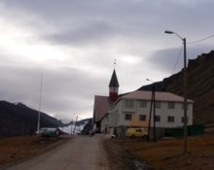
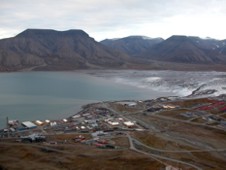
Church in LYB and a view of the town with the mouth of Adventelva.
Sveagruva
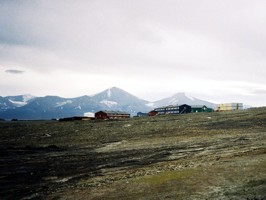 On the south of Nordenskjold land, at the end of Van Mijens fjord, there is a mining base
of Sveagruva. It consists of one coal mine that belongs to Store Norske Kullkompani, the
local mining company. A little more than 200 people works here.
On the south of Nordenskjold land, at the end of Van Mijens fjord, there is a mining base
of Sveagruva. It consists of one coal mine that belongs to Store Norske Kullkompani, the
local mining company. A little more than 200 people works here.
Sveagruva is not fit for visitors, but it is possible to send a letter from there or use the local public phone. We have not tried to replenish our supplies, but probably thanks to a good luck for people, we not only got extremely well fed in the local mess-room, we even spent the night indoors in a well heated dressing room and we enjoyed shower and sauna. All for free. According to our host it was highly unofficial.
Ny Alesund
To the north, out of the area reachable from Isfjord, there is a scientific base Ny Alesund. It used to be a mining settlement too and from that times, there is the northernmost functional railroad kept as a memorial. Ny Alesund had lived through its greatest glory in 1920's when airships of polar expeditions were using it as a starting point. Now only a small scientific community of some 40 people remains and is occassionally visited by tourships on the way to the north to observe walrus...
Russian settlement
Barentsburg
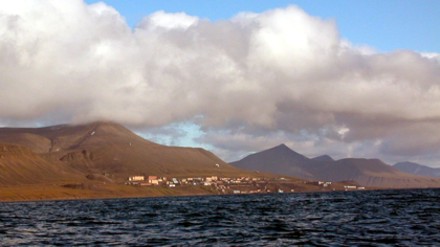
Southwest of LYB Gronfjord opens into Isfjord from the south and on its coast there lies the russian mining town of Barentsburg. About 900 people works here. The Norwegians from LYB make boat tours to Barentsburg for tourists.
The town clearly shows that miners were public heros in Soviet Union. Not that mining in Svalbard would be less then heroic job... The town has been built in soviet grand style and equipped with various attractions such as a large sports hall. Other reminders of the past are the bust of Lenin and great sign on the mountain side above the place saying "MUPY MUP". The road from town to helicopter airfield on the coast of Isfjord is lined with piles of old machinery and with some unfinished buildings.
But the local people are mostly very nice. Or they ignore strangers completely. Our encounters have been very pleasant so far.
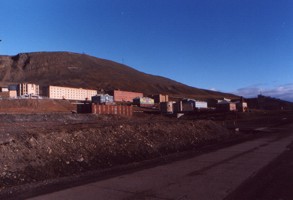
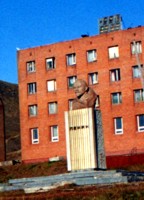
Barentsburg and reminder of the past
Pyramiden
To the northeast, at the other end of Isfjord, there is similar base named Pyramiden after the surrounding mountains. It was deserted in late 1990's allegedly in the matter of days. For its unique atmosphere of a ghost-town it is a frequent goal for longyearbyen's fleet of tourships.
Grumantbyen and Colesbukta
On the coast of Isfjord, halfway between Barentsburg and LYB, there is Colesbukta bay. There used to be a coal port for the russian mine in Grumantbyen, which is a little farther along the coast towards LYB. Both settlements have been deserted since early 1960's, only in Colesbukta, there still are several buildings kept inhabitable. The remains of the railroad between the two places now serve as a path for those few backpackers passing through the area.
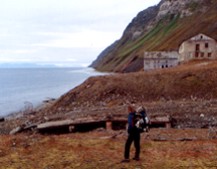
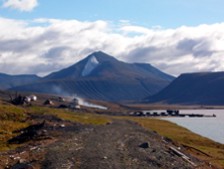
Ruin of Grumantbyenu and view of Colesbuktu just after the fire in August 2004
Polish settlement
Poland keeps a small research station on the coast of Hornsund in the south of Spitzbergen island.
Czech research station
For us it is interesting that since summer 2008 there is working Czech research station on Svalbard established by University of South Bohemia. The station's crew is searching for biolocical aspects of climate changes in the area on the coast of Petunia bukta near Pyramiden. Their results will be processed within larger projects run by Norsk Polar Institut.
The station consists of two containers (habitat and storage) on the wooden pier in Pyramiden harbor. Besides that, there is the cabin in Petunia bukta rented from Russians where is the laboratory.
